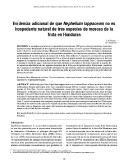| dc.description.abstract | Se condujeron pruebas de oviposición forzada durante 1999 para evaluar el rambután, Nephelium lappaceum, como hospedante de tres especies de moscas de la fruta: Ceratitis capitata (Wiedemann), Anastrepha ludens (Loew) y Anastrepha obliqua (Macquart) en Honduras. En las pruebas, frutas sin daño e intencionalmente dañadas, mantenidas en cajas con hospedantes conocidos y sin ellos, fueron expuestas a altas densidades poblacionales de las tres especies de moscas de la fruta. Para dañar el N. lappaceum, se removió una porción de la concha o la mayoría de los espineretes. No se observó ningún intento de oviposición, huevos o larva de ninguna de las especies de moscas de la fruta en las frutas de N. lappaceum sin daño. Solo C. capitata ovipositó y alcanzó el estado de pupa y solo ocurrió en frutas dañadas, a las cuales se les había removido la concha. Este reporte de inhabilidad de tres especies de moscas de la fruta para ovipositar sobre frutos sanos y maduros de N. lappaceum corrobora los resultados obtenidos en experimentos anteriores en Honduras, que argumentan que los envíos comerciales de frutas de rambután sin daño no representan un riesgo para los países libres de moscas de la fruta. Forced infestation tests were conducted during 1999 to evaluate rambutan as a host of three species of fruit flies: Ceratitis capitata (Wiedemann), Anastrepha ludens (Loew) and Anastrepha obliqua (Macquart) in Honduras. In the tests intentionally damaged and undamaged rambutan fruits, kept in cages together with and without known host fruits, were exposed to high-density populations of the three species of fruit flies. To damage the rambutan either a portion of the peel or most of the spinnerets were removed. Neither oviposition nor eggs nor larvae were observed of any of the species of fruit flies on undamaged rambutan fruits. Only C. capitata oviposited and completed pupation and only on the peel-damaged rambutan fruit. This report of inability by three fruit fly species to oviposit on mature, undamaged rambutan fruit corroborates the results of earlier trials in Honduras and argues that commercial shipments of undamaged rambutan fruit do not represent a risk to fruit fly free countries. | es_ES |


